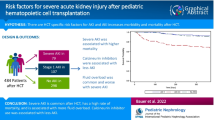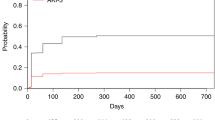Abstract
Acute kidney injury (AKI) after hematopoietic stem cell transplantation (HSCT) is associated with high mortality rates. To determine the incidence and risk factors associated with AKI in patients undergoing HSCT during the infusion period, patients admitted for HSCT from 2012 to 2015 were studied. AKI was classified according to the KDIGO (Kidney Disease Improving Global Outcomes) criteria. We analyzed the main comorbidities, underlying conditions, types of transplant, preparative regimens, and use of potentially nephrotoxic drugs as risk factors for AKI. Among the 180 patients (median age 53 years), 69 (36.5%) developed AKI (23 KDIGO 1, 28 KDIGO 2, and 18 KDIGO 3), 49 (50.0%) undergoing allogeneic and 20 (22.3%) autologous transplantation, and 18 (9.4%) required dialysis. The main comorbidities were hypertension (38; 19.8%), and diabetes (19; 9.9%). The median pre-transplant creatinine was 0.7 mg/dl. Twenty-one patients died (10.9%). The risk factors for AKI in allogeneic HSCT were as follows: baseline estimated glomerular filtration rate (eGFR) (RR 1.12 (1.02–1.22), p = 0.019), use of vasopressors (RR 3.72 (2.20–6.29), p < 0.001), and use of methotrexate (RR 1.83 (1.08–3.11), p = 0.025). Male gender (RR 5.91 (1.65–21.16), p = 0.006), baseline eGFR (RR 1.22 (1.04–1.43), p = 0.011), and use of aminoglycosides (RR 3.92 (1.06–14.44), p = 0.041) were the risk factors for AKI associated with autologous HSCT. During hospitalization for HSCT, AKI was a common problem. The use of a low dose of methotrexate to prevent graft versus host disease was associated with its occurrence.
Similar content being viewed by others
References
Miller BW (2006) Chronic kidney disease in solid-organ transplantation. Adv Chronic Kidney Dis 13(1):29–34. https://doi.org/10.1053/j.ackd.2005.10.007
Lopes JA, Jorge S. Acute kidney injury following HCT: incidence, risk factors and outcome. Bone Marrow Transpl. 2011;46(11):1399–1408. doi:bmt201146 [pii]\rhttps://doi.org/10.1038/bmt.2011.46
Lam AQ, Humphreys BD (2012) Onco-nephrology: AKI in the cancer patient. Clin J Am Soc Nephrol. https://doi.org/10.2215/CJN.03140312
Hingorani S (2016) Renal complications of hematopoietic-cell transplantation. N Engl J Med 374(23):2256–2267. https://doi.org/10.1056/NEJMra1404711
Darmon M, Ciroldi M, Thiery G, Schlemmer B, Azoulay E (2006) Clinical review: specific aspects of acute renal failure in cancer patients. Crit Care 10(2):211. https://doi.org/10.1186/cc4907
Lopes JA, Jorge S, Neves M. Acute kidney injury in HCT: an update. 2016;51(6):755–762. doi:https://doi.org/10.1038/bmt.2015.357
Filiponi TC, Requiäo-Moura LR, Tonato EJ, De Matos ACC, Pacheco E, Silva-Filho A, De Souza Durão M (2015) Hospital admission following acute kidney injury in kidney transplant recipients is associated with a negative impact on graft function after 1-year. PLoS One 10(9):1–12. https://doi.org/10.1371/journal.pone.0138944
Levey AS, Stevens LA, Schmid CH, Zhang YL, Castro AF 3rd, Feldman HI, Kusek JW, Eggers P, van Lente F, Greene T, Coresh J, CKD-EPI (Chronic Kidney Disease Epidemiology Collaboration) A new equation to estimate glomerular filtration rate disclosure of conflicts of interest: we have received confirmation from Drs. Ann Intern Med 2009;150(9):604–612
AB Farris, D Taheri, T Kawai, L Fazlollahi, W. Wong, N Tolkoff-Rubin T, Spitzer, AJ Iafrate, FI Preffer, SA LoCascio, B Sprangers, S Saidman R, Smith, AB Cosimi, M Sykes, DH Sachs and RC. Acute renal endothelial injury during marrow recovery in a cohort of combined kidney and bone marrow allografts. Am J Transpl 2011;11(7):1464–1477
Małyszko J, Kozlowski L, Kozłowska K, Małyszko M, Małyszko J. Cancer and the kidney: dangereoux liasons or price paid for the progress in medicine? 2017. www.impactjournals.com/oncotarget
Canet E, Zafrani L, Lambert J et al (2013) Acute kidney injury in patients with newly diagnosed high-grade hematological malignancies: impact on remission and survival. PLoS One. https://doi.org/10.1371/journal.pone.0055870
Kersting S, Koomans HA, Hené RJ, Verdonck LF (2007) Acute renal failure after allogeneic myeloablative stem cell transplantation: retrospective analysis of incidence, risk factors and survival. Bone Marrow Transplant 39(6):359–365. https://doi.org/10.1038/sj.bmt.1705599
Parikh CR, Schrier RW, Storer B, Diaconescu R, Sorror ML, Maris MB, Maloney DG, McSweeney P, Storb R, Sandmaier BM (2005) Comparison of ARF after myeloablative and nonmyeloablative hematopoietic cell transplantation. Am J Kidney Dis 45(3):502–509. https://doi.org/10.1053/j.ajkd.2004.11.013
Parikh CR, Sandmaier BM, Storb RF, Blume KG, Sahebi F, Maloney DG, Maris MB, Nieto Y, Edelstein CL, Schrier RW, McSweeney P (2004) Acute renal failure after nonmyeloablative hematopoietic cell transplantation. J Am Soc Nephrol 15(7):1868–1876. https://doi.org/10.1097/01.ASN.0000129981.50357.1C
Liu H, Li YF, Liu BC, Ding JH, Chen BA, Xu WL, Qian J (2010) A multicenter, retrospective study of acute kidney injury in adult patients with nonmyeloablative hematopoietic SCT. Bone Marrow Transpl 45(1):153–158. https://doi.org/10.1038/bmt.2009.99
Okusa MD, Davenport A (2014) Reading between the (guide)lines - the KDIGO practice guideline on acute kidney injury in the individual patient. Kidney Int 85(1):1–19. https://doi.org/10.1038/ki.2013.378.Reading
Benoit SW, Goldstein SL, Dahale DS et al (2019) Reduction in nephrotoxic antimicrobial exposure decreases associated acute kidney injury in pediatric hematopoietic stem cell transplant patients. Biol Blood Marrow Transplant 000:1–5. https://doi.org/10.1016/j.bbmt.2019.04.022
McWilliam SJ, Antoine DJ, Smyth RL, Pirmohamed M (2017) Aminoglycoside-induced nephrotoxicity in children. Pediatr Nephrol 32(11):2015–2025. https://doi.org/10.1007/s00467-016-3533-z
Decker BS, Molitoris BA. Aminoglycoside-induced nephrotoxicity. Compr Toxicol Third Ed. 2017;14–15(6):256–273. doi:https://doi.org/10.1016/B978-0-12-801238-3.95646-0
Lopes JA, Jorge S (2013) The RIFLE and AKIN classifications for acute kidney injury: a critical and comprehensive review. Clin Kidney J 6(1):8–14. https://doi.org/10.1093/ckj/sfs160
Patzer L, Kentouche K, Ringelmann F, Misselwitz J (2003) Renal function following hematological stem cell transplantation in childhood. Pediatr Nephrol 18(7):623–635. https://doi.org/10.1007/s00467-003-1146-9
K J, Pui, ChingHoward SC, McCormic-Hon, Buddington RK, Harvey RD. Preventing and managing toxicities of high-dose methotrexate. Oncologist. 2016:1–12. doi:https://doi.org/10.1634/theoncologist.2015-0164
Widemann BC, Balis FM, Kim AR, Boron M, Jayaprakash N, Shalabi A, O’Brien M, Eby M, Cole DE, Murphy RF, Fox E, Ivy P, Adamson PC (2010) Glucarpidase, leucovorin, and thymidine for high-dose methotrexate-induced renal dysfunction: clinical and pharmacologic factors affecting outcome. J Clin Oncol 28(25):3979–3986. https://doi.org/10.1200/JCO.2009.25.4540
Alexandre P. Garneau MS, Julie Riopel MD, Paul Isenring, M.D. PD. Acute methotrexate-induced crystal nephropathy. N Engl J Med 2015;373(27):2691–2692
Author information
Authors and Affiliations
Corresponding author
Ethics declarations
Conflict of interest
The authors declare that they have no conflicts of interest.
Ethical approval
The hospital’s Institutional Review Board (under number 1.370.103) approved the study protocol, and the study was in accordance with the current version of the Helsinki Declaration.
Statement of informed consent
Due to the nature of the study, based on a retrospective review of medical charts, the informed consent form (ICF) for patients was waived.
Additional information
Publisher’s note
Springer Nature remains neutral with regard to jurisdictional claims in published maps and institutional affiliations.
Electronic supplementary material
ESM 1
(DOCX 32 kb)
Rights and permissions
About this article
Cite this article
Ferraz, F.T.P., Marra, A.R., Hamerschlak, N. et al. The use of low doses of methotrexate during peri-cell infusion period may be a risk factor for acute kidney injury in patients subjected to hematopoietic stem cell transplantation. Ann Hematol 99, 627–633 (2020). https://doi.org/10.1007/s00277-020-03928-4
Received:
Accepted:
Published:
Issue Date:
DOI: https://doi.org/10.1007/s00277-020-03928-4




